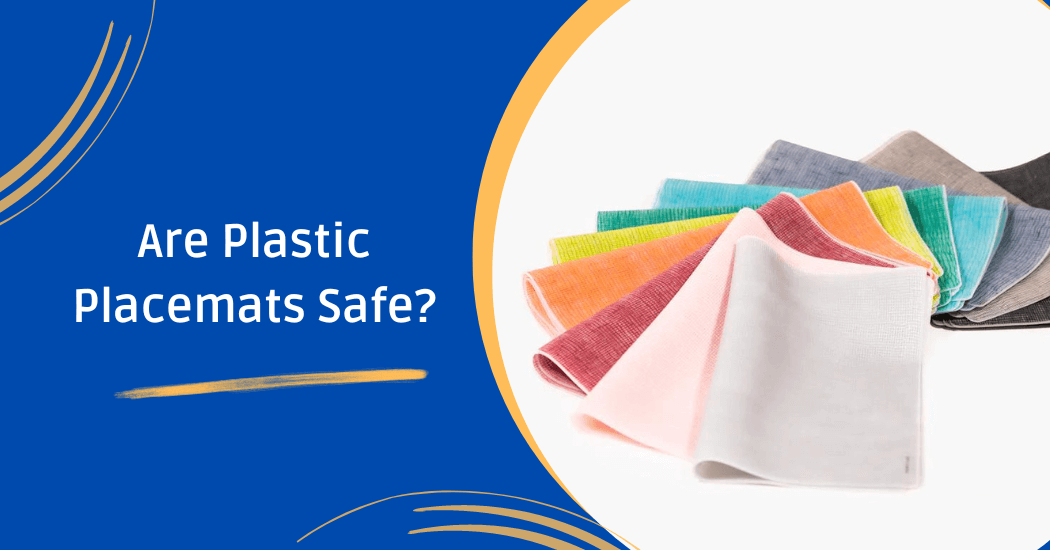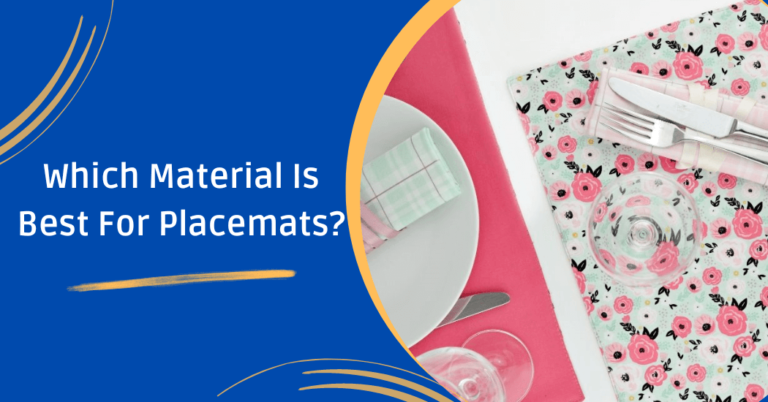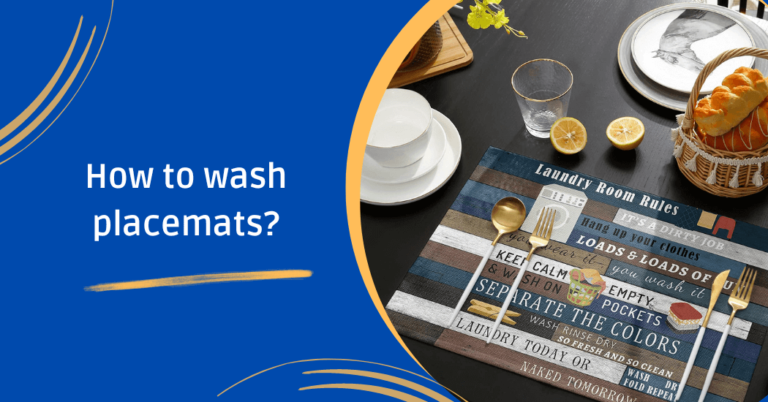Are plastic placemats safe?
Are you concerned about the safety of the plastic placemats you’ve been using? You’re not alone. With increasing awareness about the possible health and environmental hazards of certain plastics, many people are reevaluating the materials they use in their everyday lives, especially when it comes to mealtimes.
In this post, we’ll delve deep into the question, “Are plastic placemats safe?” We’ll explore the different types of plastics used in placemats, discuss the potential risks and benefits of each and even recommend some alternative options for those wanting to make a change.
By the end of this article, you’ll have a better understanding of the role that plastic placemats play in your household and what steps you can take to ensure safety and sustainability.
Are plastic placemats safe?
It depends on the type of plastic used in your placemats. Most commercially available plastic placemats are made from polypropylene (PP) or polyethylene (PE). Both plastics are considered safe for food contact but PP is slightly more durable and heat-resistant than PE.
However, it’s important to note that some plastics contain additives, such as bisphenol A (BPA), which can be hazardous to your health. If you’re concerned about BPA, look for placemats that are labeled “BPA-free.”
Some plastic placemats may also contain phthalates, another type of chemical additive with potential health risks. The best way to avoid these chemicals is to purchase placemats made with high-quality plastic such as PE or PP.
It’s also important to pay attention to the recycling symbols on your placemats. Plastics that bear a #7 recycling symbol are not recyclable and should be avoided, as they may contain potentially hazardous chemicals.
Plastic placemats can also pose an environmental hazard if not disposed of properly. To reduce your ecological footprint, look for placemats made from recycled materials, such as polyethylene terephthalate (PET) or high-density polyethylene (HDPE).
Pros and cons of using plastic placemats
Pros of using plastic placemats
- Durability: Plastic placemats are designed to last. They are resistant to tearing and staining, making them a practical choice for daily use.
- Easy maintenance: Plastic placemats can be easily cleaned with a simple wipe-down, making them ideal for households with children.
- Affordability: Compared to placemats made from other materials, plastic ones tend to be cost-effective.
- Variety: Plastic placemats come in a wide range of colors, patterns and designs, allowing you to easily change the look of your dining table.
Cons of using plastic placemats
- Potential health risks: Some plastic placemats may contain hazardous additives like BPA and phthalates.
- Environmental impact: Plastics are not biodegradable and can harm the environment if not disposed of properly.
- Heat sensitivity: Plastic placemats may warp or become discolored if exposed to high temperatures.
- Less elegant: Plastic placemats might not provide the same aesthetic appeal as those made from natural materials like linen or bamboo.
- Lack of absorbency: Placemats made from plastic do not absorb spills as well as those made from natural materials, so they may require more frequent cleaning.
- Allergens: Plastic placemats can trap allergens like dust and pet hair, which may trigger respiratory issues or other allergies in sensitive individuals.
- Chemical odors: Some plastic placemats may have a chemical smell that can linger even after cleaning. This odor might be unpleasant for some people.
- Dog chewing: If you have pets in your home, plastic placemats may be a tempting target for their chewing habits. Dogs and cats can easily damage or tear through these mats.
- Tendency to slip: Plastic placemats often slide around on the table due to their smooth surface, which can be disruptive during meals.
- Low durability: Plastics are not as strong and durable as other materials, so these placemats may need to be replaced more frequently than others.
Also Read: Which material is best for placemats?
What other sustainable alternatives to plastic placemats exist?
Other sustainable alternatives to plastic placemats include:
- Natural fibers: Natural fibers, such as cotton, linen, jute and hemp are all durable and eco-friendly alternatives to plastic placemats. They can be easily washed in the washing machine or by hand and come in a variety of styles and colors.
- Cork: Cork is another eco-friendly material that can be used for placemats. It has natural anti-bacterial properties and is both heat and water-resistant, making it ideal for use in the kitchen.
- Recycled Tyvek: Tyvek is a strong and durable synthetic material that can be recycled into placemats. Tyvek placemats are water-resistant and easy to clean, as well as are available in a range of colors and designs.
- Wood: Wooden placemats are also a great eco-friendly option, as they can be easily washed and are available in a variety of styles. They can be treated with vegetable oil or wax to make them water-resistant and longer-lasting.
- Melamine: Finally, melamine is another durable option that is available in a range of styles and colors. It is dishwasher and heat-safe, making it a great choice for placemats.
- Reusable placemats: Reusable placemats are an even more sustainable option as they can be used over and over again. They come in a variety of materials such as fabric, neoprene, or insulated foam and can also be easily washed in the washing machine.
- Organic cotton placemats: Organic cotton placemats are another great option for those looking for an eco-friendly alternative to plastic. They are made from organic cotton which is grown without the use of pesticides or other chemicals, making them a safe and sustainable choice.
- Hemp fabric placemats: Hemp fabric is not only sustainable but also durable and water-resistant. It is an ideal material for placemats, as it can be easily washed and is resistant to mildew and mold.
- Natural fiber placemats: Natural fibers such as jute, sisal or coir are also a great option for eco-friendly placemats. They are strong and durable, as well as being available in a variety of colors. Plus, they are also resistant to mold and mildew.
- Bamboo placemats: Finally, bamboo placemats are a great alternative to plastic. They are strong and durable, as well as being resistant to mold and mildew. Plus, they are also stylish and available in a range of designs.
How to safely use plastic placemats?
When using plastic placemats, it is important to take the necessary safety precautions. These include:
- Always check that your placemat is heat-resistant before placing hot dishes or pans on it.
- Make sure you follow the manufacturer’s instructions when cleaning and storing plastic placemats, as some types may require hand washing or special cleaning products.
- Avoid leaving wet placemats on a surface as this can cause staining and discoloration.
- Refrain from using plastic placemats outdoors, as they are likely to fade quickly in direct sunlight.
- Store your plastic placemats flat when not in use, so that they do not become warped or misshapen.
- Replace plastic placemats when they become cracked, torn or stained, as this could lead to contamination of food and germs.
- Finally, always dispose of your plastic placemats responsibly either recycle them or send them off for commercial recycling. This can help reduce the amount of plastic waste produced each year.
By taking these simple precautions, you can rest assured that your plastic placemats will stay in excellent condition for many years to come!
Also Read: What can I use instead of placemats?
Wrap Up
With appropriate care and usage, plastic placemats can indeed be a safe and practical addition to any dining setting. While concerns around plastic items are valid, manufacturers have increasingly prioritized safety and durability, producing placemats that are heat-resistant, easy to clean and recyclable.
The key is to ensure that you follow all safety guidelines provided by the manufacturer and replace any placemats that show signs of damage or wear. In doing so, you can enjoy the convenience and aesthetic appeal of plastic placemats with peace of mind, knowing you are using them safely.








